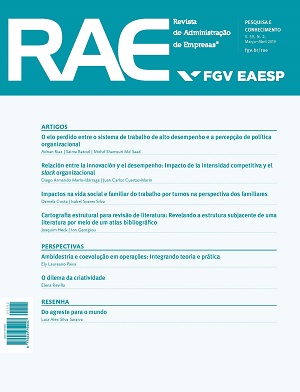Ambidexterity and co-evolution in operations: Integrating theory and practice
Main Article Content
Abstract
What factors influence changes related to operations in companies? Usually, the operations management area prioritizes a technical view of its issues, often with limited theoretical support, consequently distancing itself from other areas of business administration. How could the co-evolution theory help this understanding by making contributions to research and practice of operations management? In this context, the development of a new product or business process leads to significant changes in the way a company configures its operations. The growth of e-commerce in recent decades illustrates how a change takes place not just in the company’s strategy, but also in the operations along the entire supply chain. However, what would drive change? Several answers have been proposed. Initially, one thinks of internal resources as the main drivers of such changes. Even with criticism, the resource-based view (RBV) has assumed a predominant role in operations research (Bromiley & Rau, 2016). According to RBV, internal resources, including the business leader, are essential to strategies of and changes in the company’s operations (Hitt, Xu, & Carnes, 2016). However, external causalities, such as the influence of the industrial sector, are also important. Considering this approach, it is valid to consider Michael Porter’s influence in the way the strategy of companies has been thought for decades (Hayes & Pisano, 1996).
Downloads
Metrics
Article Details
A RAE compromete-se a contribuir com a proteção dos direitos intelectuais do autor. Nesse sentido:
- adota a licença Creative Commoms BY (CC-BY) em todos os textos que publica, exceto quando houver indicação de específicos detentores dos direitos autorais e patrimoniais;
- adota software de detecção de similaridades;
- adota ações de combate ao plagio e má conduta ética, alinhada às diretrizes do Committee on Publication Ethics (COPE)
References
Birkinshaw, J., & Gupta, K. (2013). Clarifying the distinctive contribution of ambidexterity to the field of organization studies. Academy of Management Perspectives, 27(4), 287-298. doi:10.5465/amp.2012.0167
Bosch, F. A. J. Van den, Volberda, H. W., & Boer, M. De. (1999). Coevolution of firm absorptive capacity and knowledge environment: Organizational forms and combinative capabilities. Organization Science, 10(5), 551-568.
Bromiley, P., & Rau, D. (2016). Operations management and the resource based view: Another view. Journal of Operations Management, 41, 95-106. doi:10.1016/j.jom.2015.11.003
Galunic, D. C., & Eisenhardt, K. M. (1996). The evolution of intracorporate domains: Divisional charter losses in high-technology, multidivisional corporations. Organization Science, 7(3), 255-282. doi:10.1287/orsc.7.3.255
Hashiba, L., & Paiva, E. L. (2016). Incorporating sustainability in the new product development process: An analysis based on the resource-based view. BASE-Revista de Administração e Contabilidade da Unisinos, 13(3), 188-199. doi:10.4013/base.2016.133.01
Hayes, R. H., & Pisano, G. P. (1996). Manufacturing strategy: At the intersection of two paradigm shifts. Production and Operations Management, 5(1), 25-41. doi:10.1111/j.1937-5956.1996.tb00383.x
Hitt, M. A., Xu, K., & Carnes, C. M. (2016). Resource based theory in operations management research. Journal of Operations Management, 41, 77-94. doi:10.1016/j.jom.2015.11.002
Huygens, M., Bosch, F. A. Van Den, Volberda, H. W., & Baden-Fuller, C. (2001). Co-evolution of firm capabilities and industry competition: Investigating the music industry, 1877-1997. Organization Studies, 22(6), 971-1011.
Kristal, M. M., Huang, X., & Roth, A. V. (2010). The effect of an ambidextrous supply chain strategy on combinative competitive capabilities and business performance. Journal of Operations Management, 28(5), 415-429. doi:10.1016/j.jom.2009.12.002
Kortmann, S., Gelhard, C., Zimmermann, C., & Piller, F. T. (2014). Linking strategic flexibility and operational efficiency: The mediating role of ambidextrous operational capabilities. Journal of Operations Management, 32(7-8), 475-490. doi:10.1016/j.jom.2014.09.007
Lewin, A., & Volberda, H. (1999). Prolegomena on coevolution: A framework for research on strategy and new organizational forms. Organization Science, 10(5), 519-534.
March, J. (1994). The evolution of evolution. In J. Baum, & J. Singh (Eds.), Evolutionary dynamics of organizations (pp. 39-52). New York, NY: Oxford University Press.
O’Reilly, C. A., III, & Tushman, M. L. (2004). The ambidextrous organization. Harvard Business Review, 82(4), 74.
Rodrigues, S., & Child, J. (2003). Co‐evolution in an institutionalized environment. Journal of Management Studies, 40(8), 2137-2162. doi:10.1046/j.1467-6486.2003.00415.x
Teece, D., & Pisano, G. (1994). The dynamic capabilities of firms: An introduction. Industrial and Corporate Change, 3(3), 537-556. doi:10.1093/icc/3.3.537-a
Wheelwright, S. C., & Hayes, R. H. (1985). Competing through manufacturing. Harvard Business Review, 63(1), 99-109.







